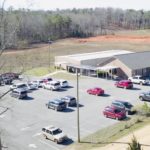By Ronald L. Masten
Partnership on purpose, spiritual fervency, and intentional outreach into the community will characterize the church in the future, and the future begins now. Developing leaders for ministry rural churches necessities relevant ministry that includes, spiritual fervency, authenticity, community outreach, and partnership.
The current state of ministry in rural Sandhills of Nebraska struggles with the following questions: “How will relevant ministry survive as the church moves into the future? What will the ministry look like? Who will lead outreach? How will missions be supported moving forward?” Rural communities face many struggles in these times; they experienced a decline and loss of families over the past several decades, which resulted in smaller churches. World Population Review reports Thomas County Population in 1980 at 973 people and 2018 numbers at 720.1 Many trends ignored or thought small rural ministry as less than larger metro churches. Karl Vaters stated in, The Grasshopper Myth, “Half of all Christians in America and far more than half of Christians worldwide attend a Small Church.”2 This study researched the challenges and issues of current ministry, and the opportunity for churches to partner and cooperate together ensuring productive ministry and evangelism for the future.
The research included interviews of pastors, lay leaders, members and adherents, and small-town residents using a questionnaire designed to provide answers to focused questions with persons involved in the rural ministry context and community. What percentage of pastors serve in bi-vocational roles? What level of education and experience do they have? What role do laypeople play in leadership? What level of cooperation between area churches ensures successful ministry in the future? This research gathered responses from diverse groups in the churches and ministries engaged multiple viewpoints ensuring good research data from interviews from current ministries and those engaged in evangelism whether clergy or lay leadership.
The church must recognize that collaboration and partnership will not just evolve on its own. This new paradigm engages the church in a sense of urgency rooted in seeking God to give direction and guidance moving forward. God will lead the changes, partnerships, spiritual renewal, and missional evangelism through contextualization and intentional evangelism.
This research project survey demonstrated that the rural churches in the Sandhills of Nebraska and around America still have life; however, there is a sense of urgency in the church to find ministry answers to go forward. In a rural ministry context, authenticity became a key to influence and leading change in people’s lives and the converse remained true.
People in the rural context desire authenticity, in ministry, and in outreach. In small communities, genuine ministry becomes immediately apparent, so the lack of genuine concern and compassion compels the rural community to appraise the messenger as irrelevant. Sandhills people ignore the inauthentic rather than accepting them as a true missionary. Rural people immediately recognized inauthentic life and any opportunity to lead them in change will become lost.
Relevant ministries will not only survive in the future, but it will also thrive. Small-town rural pastors and laypeople exhibit optimism and hope. We can rejoice in the knowledge that we are in the midst of mission, guided by the Holy Spirit, that will lead this revival and breathe new life into the backroads of our state, country, and world.
1 WorldPopulationReview.com; Nebraska, February 17, 2020. (accessed 2020-5-28).
2 Karl Vaters, The Grasshopper Myth (New Small Church, New Song Media, 2012), 41.





















